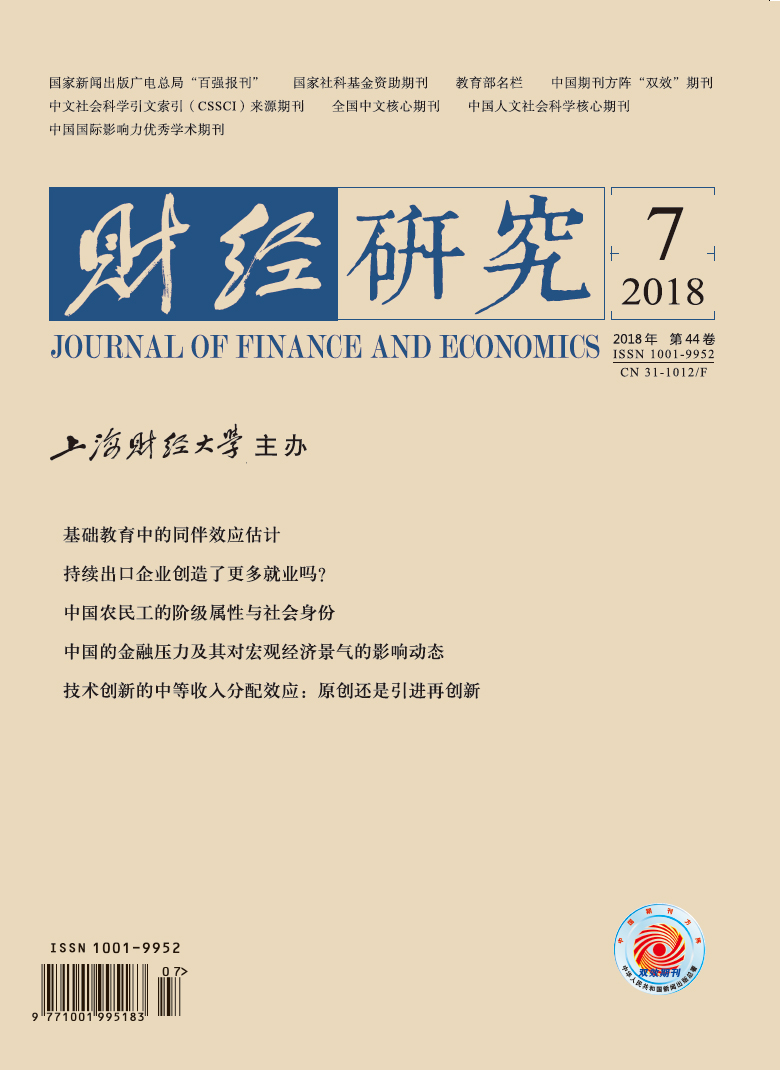出口能够带来就业效应,这已成为一个共识;但以往研究只关注了出口与否对就业产生的不同影响,并没有讨论出口持续程度的差异造成的就业效应偏差。文章使用中国工业企业数据,首次考察了企业出口持续程度与企业就业人数的关系。研究发现:(1)企业出口持续时间的提高确实有助于创造更多的就业,且这种就业创造效应是动态的。(2)持续出口企业创造更多就业的机制在于,持续出口企业更有可能获得高额利润,具备更好的创造和维持岗位的能力,从而带来更大的就业规模。(3)2005年的汇率制度改革并没有显著改变持续出口企业创造更多就业的事实。因此,政府在鼓励出口时,应该更加重视帮助企业维持其持续出口能力,通过加大对出口企业产品研发和制造的资金与技术支持,从根本上提升出口企业的产品质量和经营管理能力。
持续出口企业创造了更多就业吗?
摘要
参考文献
17 史青, 李平. 再议中国企业出口的就业效应[J]. 财贸经济, 2014, (10): 83—93. DOI:10.3969/j.issn.1005-913X.2014.10.050
26 Baier S L, Dwyer Jr G P, Tamura R. How important are capital and total factor productivity for economic growth?[J]. Economic Inquiry, 2006, 44(1): 23—49. DOI:10.1093/ei/cbj003
27 Berman E, Bound J, Griliches Z. Changes in the demand for skilled labor within U. S. manufacturing: Evidence from the annual survey of manufactures[J]. The Quarterly Journal of Economics, 1994, 109(2): 367—397. DOI:10.2307/2118467
28 Bernard A B, Jensen J B, Lawrence R Z. Exporters, jobs, and wages in U.S. manufacturing: 1976-1987[J]. Brookings Papers on Economic Activity: Microeconomics, 1995(1995): 67—119.
29 Bernard A B, Jensen J B. Exceptional exporter performance: Cause, effect or both[J]. Journal of International Economics, 1999, 47(1): 1—25. DOI:10.1016/S0022-1996(98)00027-0
30 Besedeš T, Prusa T J. Ins, outs, and the duration of trade[J]. Canadian Journal of Economics, 2006a, 39(1): 266—295. DOI:10.1111/caje.2006.39.issue-1
32 Besedeš T, Nair-Reichert. Firm heterogeneity, trade liberalization, and duration of trade and production: The case of India[R]. Working Paper, 2009.
33 Blundell R, Bond S. Initial conditions and moment restrictions in dynamic panel data models[J]. Journal of Econometrics, 1998, 87(1): 115—143. DOI:10.1016/S0304-4076(98)00009-8
34 Brandt L, Van Biesebroeck J, Zhang Y. Creative accounting or creative destruction? Firm-level productivity growth in Chinese manufacturing[J]. Journal of Development Economics, 2012, 97(2): 339—351. DOI:10.1016/j.jdeveco.2011.02.002
35 Chen H, Zhao C, Yu W. Continued export trade, screening-matching and gender discrimination in employment[J]. China Economic Review, 2017, 42: 88—100. DOI:10.1016/j.chieco.2016.12.001
36 Clerides S K, Lach S, Tybout J R. Is learning by exporting important?Micro-dynamic evidence from Columbia, Mexico, and Morocco[J]. The Quarterly Journal of Economics, 1998, 113(3): 903—947. DOI:10.1162/003355398555784
37 Feenstra R C, Romalis J. International prices and endogenous quality[J]. The Quarterly Journal of Economics, 2014, 129(2): 477—527. DOI:10.1093/qje/qju001
38 Görg H, Kneller R, Muraközy B. What makes a successful exporter?[R]. CEPR Discussion Paper, No. 6614, 2008.
39 Grima S, Gong Y D, Görg H, et al. Can production subsidies explain China’s export performance? Evidence from firm-level data[J]. Scandinavian Journal of Economics, 2009, 111(4): 863—891. DOI:10.1111/(ISSN)1467-9442
40 Helpman E, Melitz M J, Yeaple S R. Export versus FDI with heterogeneous firms[J]. American Economic Review, 2004, 94(1): 300—316. DOI:10.1257/000282804322970814
41 Helpman E, Itskhoki O, Redding S. Inequality and Unemployment in a Global Economy[J]. Econometrica, 2010, 78(4): 1239—1283. DOI:10.3982/ECTA8640
42 Kwan A C C, Cotsomitis J A. Economic growth and the expanding export sector: china 1952–1985[J]. International Economic Journal, 1991, 5(1): 105—117. DOI:10.1080/10168739100000008
43 Kwan A C C, Kwok B. Exogeneity and the export-led growth hypothesis: The case of China[J]. Southern Economic Journal, 1995, 61(4): 1158—1166. DOI:10.2307/1060747
45 Rauch J E, Watson J. Starting small in an unfamiliar environment[J]. International Journal of Industrial Organization, 2003, 21(7): 1021—1042. DOI:10.1016/S0167-7187(03)00018-3
引用本文
陈昊, 陈建伟, 司继春. 持续出口企业创造了更多就业吗?[J]. 财经研究, 2018, 44(7): 46-59.
导出参考文献,格式为:





 6367
6367  7514
7514

